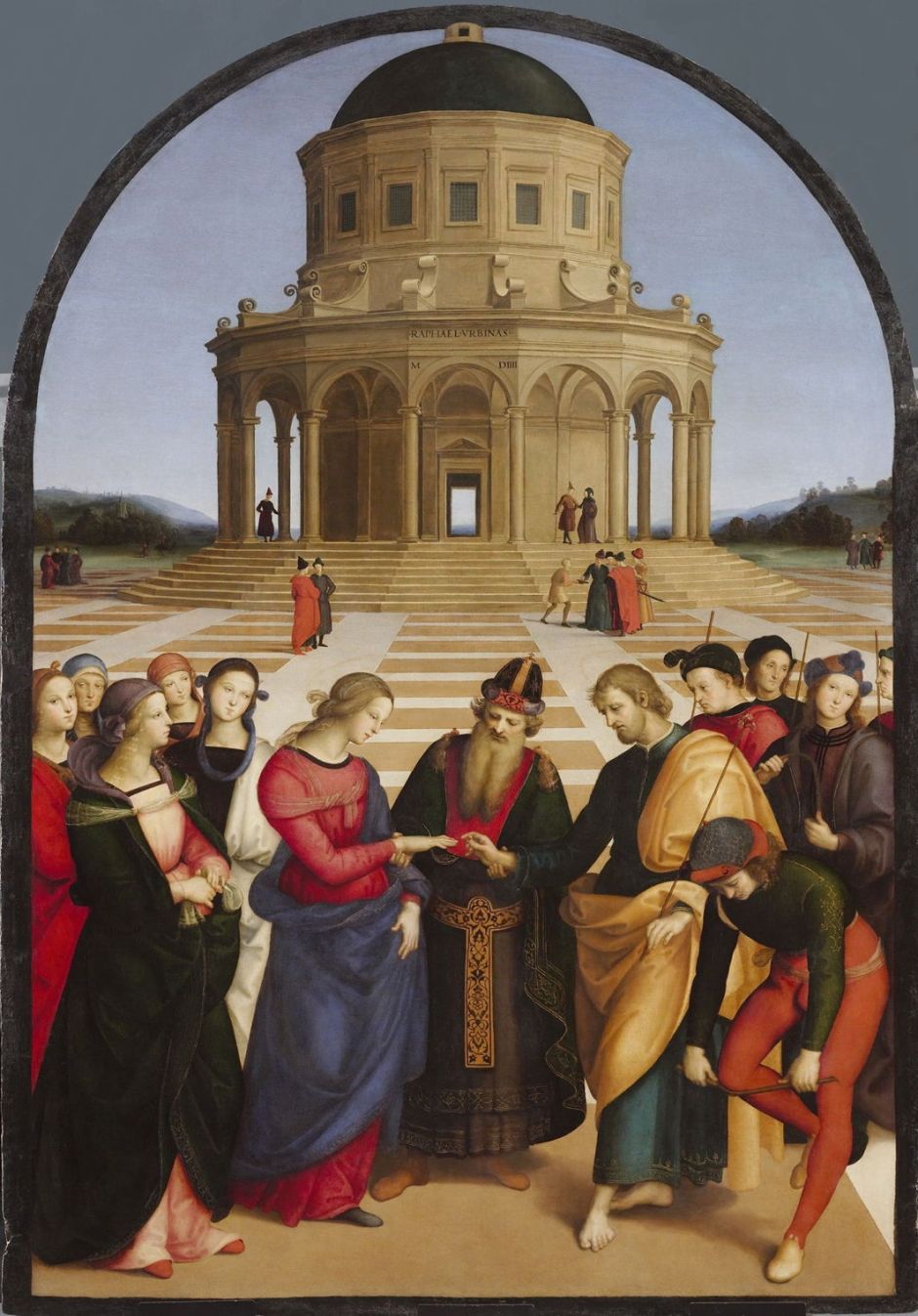Between 1503-08, Raphael appears to have worked in northern Italy, and from 1504-08 spent much of his time in Florence. This overlapped with the period in which Leonardo da Vinci was in that city, and the latter’s influence appears to have brought about significant change in the style of Raphael’s work.

At the start of this period, as shown so well in The Crucified Christ with the Virgin Mary, Saints and Angels, known also as The Mond Crucifixion (c 1502-03), Raphael was still strongly influenced by Perugino. Even the figures here are modelled after those of his teacher’s paintings. It’s believed that Raphael painted this in 1502, completing it the following year for the church of San Domenico in Città di Castello, to the north of Perugia in Italy. It’s known as the The Mond Crucifixion as it entered the collection of Ludwig Mond in London in 1892, having left Italy in around 1847.

By 1504, when Raphael painted The Marriage of the Virgin, known by its Italian name of Il Sposalizio (‘the marriage’), his style was becoming more his own. He painted this for the church of San Francesco in Città di Castello, and based it on an altarpiece painted by Perugino for Perugia Cathedral at about the same time. In contrast to Perugino’s version, Raphael shows his eye for the classical, with its grand architecture expertly projected in depth.

It’s probably the Madonna Terranuova, or Mary with the Child, John the Baptist and a Holy Boy from about 1505, which shows the first signs of Leonardo’s influence, and is recognisable as one of the first of Raphael’s many distinctive Madonnas. Its four figures are composed into a slightly asymmetrical pyramid, and their facial expressions have come a long way from his earlier works.

Another among this flurry of Madonnas which Raphael painted during this period in Florence is his justly famous Madonna of the Meadow (Madonna and Child with the Young Saint John) from 1505-06. Although the artist has inserted a date in the neckline of Mary’s dress, it remains unclear exactly which year is given. This pyramidal composition is used again in the slightly later Madonna del Cardellino and the Belle Jardinière. His modelling of flesh is now fully mature, and he adds finely-painted flowers and plants.
The artist is thought to have given this painting to Taddeo Taddei (1470-1528), a gift which is mentioned by Vasari in his biography. Taddei was a flourishing merchant in Florence, who was a patron of both Raphael and Michelangelo.

Raphael’s Holy Family with a Palm Tree from 1506 shows a more extended family group, presumably during the flight to Egypt, for which the palm was a popular visual clue. In addition to three finely modelled figures, its palm tree is depicted in careful detail, even down to its realistically shaggy trunk.

Raphael’s Deposition or Entombment from 1507 was commissioned by Atalanta Baglioni of Perugia in memory of her son Grifone, who had been murdered in the town in the summer of 1500. It’s thought that the artist received her commission in 1506, and completed this painting the following year. It started off as a Pietà according to Raphael’s surviving studies, but transformed into a Deposition as those evolved. Several influences have been identified, including an engraving by Mantegna and reliefs on Roman sarcophagi.
Its composition is complex, and in parts has to address multiple intertwined limbs, showing how Raphael’s ambitions were growing. It was originally installed in the church of San Francesco in Perugia, in the Baglioni Chapel, but by 1608 had been purchased illegally and secretly removed by Pope Paul V, who gave it to his nephew Cardinal Scipio Borghese, an avid collector who was a patron of Caravaggio. The original was substituted by a copy made by Lanfranco, and at least two further copies were made.

There is doubt as to when Raphael painted this Madonna with Child on her Arm, the Tempi Madonna. Although some consider that it was finished as early as 1505, its maturity makes more probable a date nearer 1508, the end of his ‘Florentine period’. Some consider it his finest Madonna up to that date. It’s exceptional for showing the deep bond between mother and child, which could surely only have been achieved by painting this from life. This is also implied by the Madonna’s left hand, which bears the marks of life and manual work in the real world, not some abstract artist’s model.
In 1508, Raphael moved to Rome, where he was to remain for the rest of his life.

